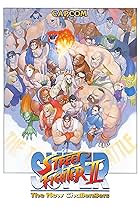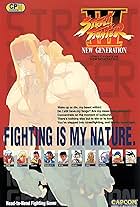Updated version of "Street Fighter II: The World Warrior (1991)". In addition to the eight main characters, the four Shadaloo Bosses (Balrog, Vega, Sagat, and M. Bison) are playable and "mir... Read allUpdated version of "Street Fighter II: The World Warrior (1991)". In addition to the eight main characters, the four Shadaloo Bosses (Balrog, Vega, Sagat, and M. Bison) are playable and "mirror matches" are possible, meaning players can select the same character.Updated version of "Street Fighter II: The World Warrior (1991)". In addition to the eight main characters, the four Shadaloo Bosses (Balrog, Vega, Sagat, and M. Bison) are playable and "mirror matches" are possible, meaning players can select the same character.
Photos
Storyline
Did you know
- TriviaThe arcade cabinet boasted "78 possible matches!"
- ConnectionsEdited into Hyper Street Fighter II: The Anniversary Edition (2003)
Featured review
Street Fighter purists know the fighting engine received minor tweaks, that Capcom addressed some of the more infamous World Warrior glitches, and that an alternate color was added to each character so he/she could fight a palette swap of themselves. However, the most important addition to Champion Edition comes in the expanded character roster.
Capcom has taken the CPU-exclusive four bosses from World Warrior and handed them to the players. So in addition to Ryu, Honda, Blanka, Guile, Ken, Chun-Li, Zangief, and Dhalsim, players for the first time take control of Balrog, Vega, Sagat, and Bison.
This would be a good time to point out that this review refers to the American version of Street Fighter II': Champion Edition (arcade). More specifically: the American names for the four bosses.
First up on the CE tour: Balrog. The African-American boxer who fights out of Las Vegas where showgirls dance on the street and bookies coach the fight from the sidelines (one of my favorite stages). Yes, Balrog, the big black burly boxer. Stereotypical? Perhaps. But what are you going to do? Easily my least favorite of the new characters due to the monotony of his arsenal (all punches, all of his specials usually involve charging and punching.) Balrog's design -- from his uninteresting appearance, wardrobe, color palette, to his stance (not to mention his silly looking block where he leans back at an unnaturally angle) -- just screams monotony.
A flight to Spain brings the gamer to a cage match with the masked Vega, the only Street Fighter character wielding a weapon. Upon his hand, the Spanish narcissist wields a Wolverinesque claw that, along with his long legs and powerful kicks, gives him formidable range. Interestingly, Vega along with Sagat in Thailand stand much taller than the non-boss characters with limbs that easily outmatch the other eight in terms of range; and yet, both can make tiny targets of themselves when crouching (and still attack with unmatched speed.) Anyway, Vega's sliding kick mixes nicely with his rolling claw for a continuous onslaught; plus Vega possesses one of the most unique attacks in the game where he flies to his cage background, climbs around, then leaps off and throws. Curiously, the move works better (timing wise) on anyone else's stage where Vega instead bounces of the side of the screen.
Off to Thailand where Sagat originally lost to Ryu, and Sagat sports a scar as proof. Tall. Lanky. Able to make himself into a tiny target. Sagat proves far more powerful than he looks. In addition to two versions of a fireball (high and low) -- both of which are among the fastest in the game -- Sagat can also throw out the dreaded Tiger Uppercut in case his prey happens to jump over one of said projectiles. On a superficial level it may be tempting to say Sagat plays like Ryu and Ken (minus the Hurricane kick); however, such an assessment would prove wrong. Despite the similarity of having both fireballs and an uppercut move, the behavior and timing of said moves are worlds apart from each other. Furthermore, Sagat's longer limbs, generally slower array of punches/kicks, shorter jump height, and the fact that (standing up) his size makes him a bigger target -- his style feels very, very different from anyone else in the game.
Lastly, the final boss: M. Bison (whose stage is also located in Thailand.) Armed with perhaps the most visually impressive move in the game, his patented Psycho Crusher where he turns himself into a fiery human torpedo and flies across the screen, Bison is quick to make an impression as one of the most potent characters in the game. I love how his hands light up in flames for some attacks. He also sports the dreaded scissor kick that features a frighteningly short recovery time. And, unlike the CPU-controlled Bison from World Warriors, requires a two-second charge time to execute which effectively prevents players from abusing. Let's not forget his ability to leap across the screen and stomp on his prey's head (as if his normal jump didn't have enough height and range) then after the stomp kick, he comes in for an additional attack even if the former were blocked.
Unfortunately, none of the boss characters feature a real ending. Instead, all four receive a generic image of themselves with scrolling text. Minor complaints? Sure. The heart of the game lay in the battles, themselves (which, like World Warriors, plays great), and not the extras. Still, the lack of fully developing characters comes across as a missed opportunity on Capcom's part.
Oh well. What else is there to say? It's still Street Fighter II ...
Capcom has taken the CPU-exclusive four bosses from World Warrior and handed them to the players. So in addition to Ryu, Honda, Blanka, Guile, Ken, Chun-Li, Zangief, and Dhalsim, players for the first time take control of Balrog, Vega, Sagat, and Bison.
This would be a good time to point out that this review refers to the American version of Street Fighter II': Champion Edition (arcade). More specifically: the American names for the four bosses.
First up on the CE tour: Balrog. The African-American boxer who fights out of Las Vegas where showgirls dance on the street and bookies coach the fight from the sidelines (one of my favorite stages). Yes, Balrog, the big black burly boxer. Stereotypical? Perhaps. But what are you going to do? Easily my least favorite of the new characters due to the monotony of his arsenal (all punches, all of his specials usually involve charging and punching.) Balrog's design -- from his uninteresting appearance, wardrobe, color palette, to his stance (not to mention his silly looking block where he leans back at an unnaturally angle) -- just screams monotony.
A flight to Spain brings the gamer to a cage match with the masked Vega, the only Street Fighter character wielding a weapon. Upon his hand, the Spanish narcissist wields a Wolverinesque claw that, along with his long legs and powerful kicks, gives him formidable range. Interestingly, Vega along with Sagat in Thailand stand much taller than the non-boss characters with limbs that easily outmatch the other eight in terms of range; and yet, both can make tiny targets of themselves when crouching (and still attack with unmatched speed.) Anyway, Vega's sliding kick mixes nicely with his rolling claw for a continuous onslaught; plus Vega possesses one of the most unique attacks in the game where he flies to his cage background, climbs around, then leaps off and throws. Curiously, the move works better (timing wise) on anyone else's stage where Vega instead bounces of the side of the screen.
Off to Thailand where Sagat originally lost to Ryu, and Sagat sports a scar as proof. Tall. Lanky. Able to make himself into a tiny target. Sagat proves far more powerful than he looks. In addition to two versions of a fireball (high and low) -- both of which are among the fastest in the game -- Sagat can also throw out the dreaded Tiger Uppercut in case his prey happens to jump over one of said projectiles. On a superficial level it may be tempting to say Sagat plays like Ryu and Ken (minus the Hurricane kick); however, such an assessment would prove wrong. Despite the similarity of having both fireballs and an uppercut move, the behavior and timing of said moves are worlds apart from each other. Furthermore, Sagat's longer limbs, generally slower array of punches/kicks, shorter jump height, and the fact that (standing up) his size makes him a bigger target -- his style feels very, very different from anyone else in the game.
Lastly, the final boss: M. Bison (whose stage is also located in Thailand.) Armed with perhaps the most visually impressive move in the game, his patented Psycho Crusher where he turns himself into a fiery human torpedo and flies across the screen, Bison is quick to make an impression as one of the most potent characters in the game. I love how his hands light up in flames for some attacks. He also sports the dreaded scissor kick that features a frighteningly short recovery time. And, unlike the CPU-controlled Bison from World Warriors, requires a two-second charge time to execute which effectively prevents players from abusing. Let's not forget his ability to leap across the screen and stomp on his prey's head (as if his normal jump didn't have enough height and range) then after the stomp kick, he comes in for an additional attack even if the former were blocked.
Unfortunately, none of the boss characters feature a real ending. Instead, all four receive a generic image of themselves with scrolling text. Minor complaints? Sure. The heart of the game lay in the battles, themselves (which, like World Warriors, plays great), and not the extras. Still, the lack of fully developing characters comes across as a missed opportunity on Capcom's part.
Oh well. What else is there to say? It's still Street Fighter II ...
- jaywolfenstien
- Nov 24, 2006
- Permalink
Details
- Release date
- Country of origin
- Official site
- Language
- Also known as
- Street Fighter II: Champion Edition (Koryu)
- Production company
- See more company credits at IMDbPro
- Color
Contribute to this page
Suggest an edit or add missing content















